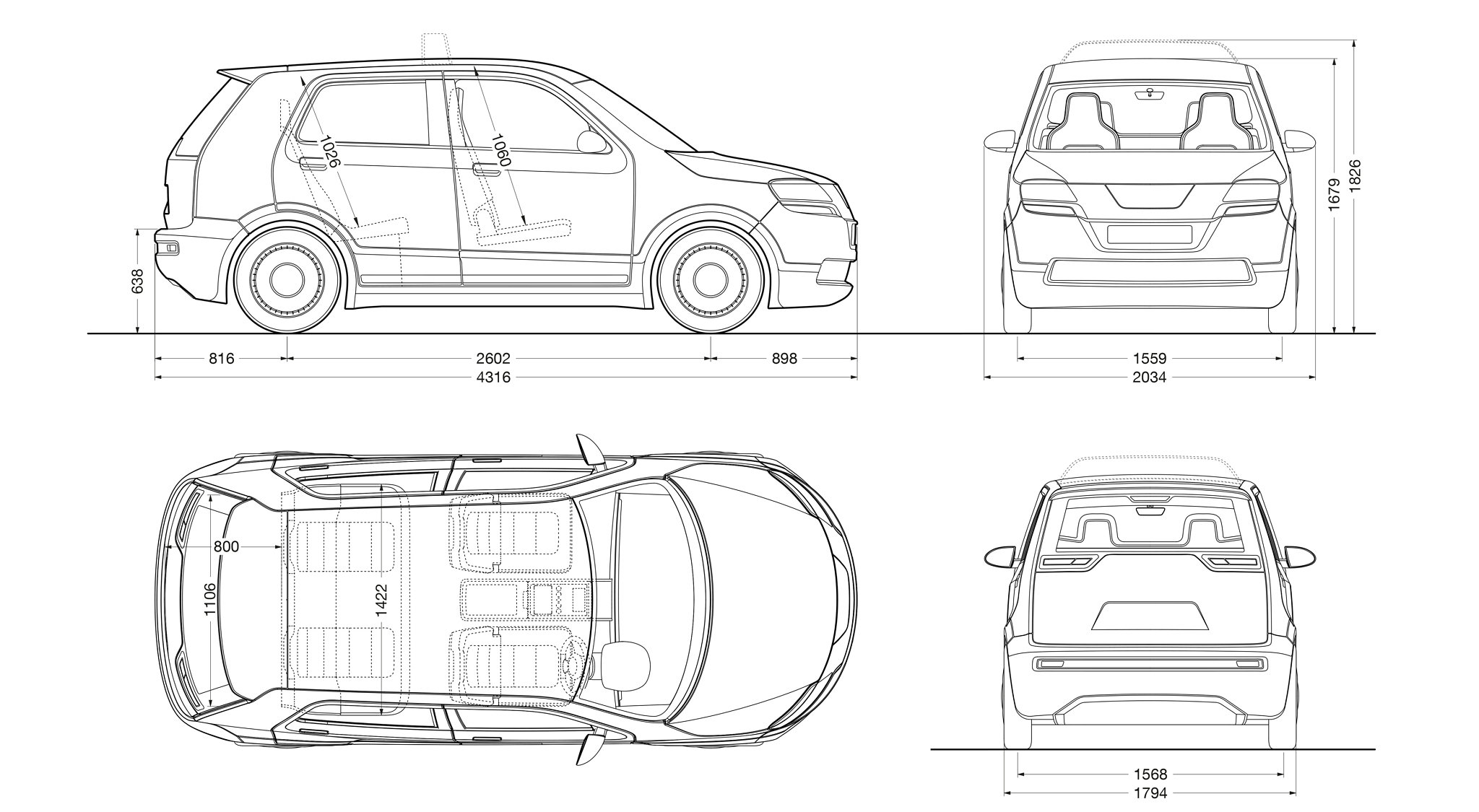time span
03 | 2012 - 01 | 2014
location
Singapore
role
designer / design consultant
team
interior-, exterior-, and product development:
Rahul Gujarathi, Goran Marinkovic, Simon Rauchbart, Andreas Schwab, Sebastian Stadler, Wotan Wilden
participants from other departements
professors
Fritz Frenkler, Markus Lienkamp, et al
ocassion
project at TUM Create Singapore / TUM Chair of Industrial Design / TUM Institute of Automotive Technology
all project partners
challenge
focus and visualise the ideas of 120 scientists, designers and engineers from over 20 countries to one single visionary concept car
Electric vehicle Asia
EVA is the first electric vehicle specifically designed as a taxi for tropical megacities. It results from a successful collaboration between Singapore’s Nangyang Technological University (NTU) and the Technische Universität München (TUM), supported from Singapore’s National Research Foundation. EVA was built from the ground up, going from concept to prototype in just two years.
The ideal concept for Singapore
By replacing fuel-burning vehicles with electric-powered ones, carbon emissions as well as local noise and hydrocarbon emissions can be reduced. The impact that taxis can make is far greater than private passenger cars due to their leveraging effect. In Singapore, taxis make up less than 3% of the vehicle population. Despite their small numbers, they account for 15% of the total distance covered by all vehicles in Singapore. Many taxis run on a two-shift rotation for up to 24 hours every day, covering an average of 520 km each.
In addition, transportation companies around the world typically repurpose passenger cars as taxis. However, the challenge of current electric vehicles is the extremely limited range and long recharge times (up to 8 hours), making them unsuitable as taxis. The heat and humidity in tropical megacities also pose unique challenges, including passenger cooling and battery pack heat management, which are specific for this part of the world. We have tackled these challenges by finding solutions for a more sustainable future in mobility.
Technical Data
For detailed information, please refer to the documentation.
Segment / Type
C-Segment / Compact Car
Curb Weight
1500 kg (including battery)
Max permissible
1900 kg
Air resistance (Cd x A)
0.34 x 2.8 m²
Max. Power
60 kW (electronically limited)
Max. Torque
223 Nm
Top Speed
111 km/h
0 – 100 km/h
10 seconds (electronically limited)
Drivetrain
Front synchronous motor
Battery
50 kWh
Range (15 min charging)
200 km (Daily driving pattern)
330 km (U.S. FTP 72 standards)
The above-mentioned specifications describe the concept car from the year 2014 and might now be out of date due to improved components.
Manufacturing EVA
Developing the electric taxi in Singapore was a feat in itself, given the country’s small automobile industry.
To transport the showcased scientific ideas in the best way we had to develop and present a concept car that has the visuals of a fully functional prototype. Combined with the start from scratch and the demanding technology the finalization of the prototype was very challenging but also satisfying. For more info, see the documentation.
Tokyo Motor Show 2013
TUM CREATE has unveiled its electric taxi prototype, codenamed EVA, at the 43. Tokyo Motor Show. The vehicle and the exhibition stand serve as a perfect platform to showcase the results of all researchers from all departments in a visual appealing way to a large audience consisting of experts and private persons.
The design of the exhibition stand is accordingly very neutral and highlights the vehicle and the research results. It also corresponds to my earlier exhibitions in emphasizing the sustainable approach of the projects through the design language.
Impact
Experts as well as international media outlets were enthusiastic about EVA. The project convinced the Jury of the Bavarian State Prize for Electromobility and was awarded the eCarTec Award 2014 in the category "Product Concept / Vision".
Just as the research that I did for my diploma thesis "Gemini - Future Mobility for Singapore" established important foundations for EVA, EVA created essential foundations for follow-up projects. The design language for vehicles made by TUM, which was already developed in the earlier project MUTE, was further established by EVA. This design language has served as an archetype for later projects.
The success of EVA was an important step in continuing the international collaboration with the project TUM Create Phase 2 - Towards the Ultimate Public Transport System.
As a result of the large impact on EVA, with my contribution to the research proposal, I could secure a larger percentage of the overall budget of TUM Create Phase 2 for our department than originally intended. Hence, our department DAM - Design for Autonomous Mobility is now able to conduct fundamental design research which is essential for the success of TUM Create Phase 2.
documentation
Project documentation and further infos.
press release 04 | 2015: english | german
press release 10 | 2014: english | german
press release 11 | 2013: english | german
Project partners
Project by
TUM CREATE Ltd
Academic partners
Technische Universität München
Nanyang Technological University
Funded by
National Research Foundation,
Prime Minister‘s Office, Singapore
Industry partners
Admiralty International Pte Ltd
HOPE Technik Pte Ltd
Sponsors
Airex AG
Behr GmbH & Co. KG
BMW Group Research and Technology
Bossard Group
Continental AG
E-T-A Elektrotechnische Aparate GmbH
IAV GmbH
IXXAT GmbH
KW automotive GmbH
Molex Singapore Pte Ltd
PROCAD GmbH & Co. KG
Samsung Asia Pte Ltd
SGL Group
SIKA AG
Stamford Tyres International
SUTD
Transcat PLM GmbH
TE Connectivity Ltd
Vicon Motion Systems Ltd
XMI Pte Ltd








































